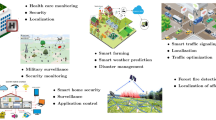Abstract
The availability and quality of information extracted from Wireless Sensor Networks (WSNs) revolutionised a wide range of application areas. The success of any WSN application is, nonetheless, determined by the ability to retrieve information with the required level of accuracy, within specified time constraints, and with minimum resource utilisation. This paper presents a new approach to localised information extraction that utilises the Watershed segmentation algorithm to dynamically group nodes into segments, which can be used as programming abstractions upon which different query operations can be performed. Watershed results in a set of well delimited areas, such that the number of necessary operations (communication and computation) to answer a query are minimised. This paper presents a fully asynchronous Watershed implementation, where nodes can compute their local data in parallel and independently from one another. The preliminary experimental results demonstrate that the proposed approach is able to significantly reduce the query processing cost and time without involving any loss of efficiency.
Access this chapter
Tax calculation will be finalised at checkout
Purchases are for personal use only
Preview
Unable to display preview. Download preview PDF.
Similar content being viewed by others
References
Abdelzaher, T., Blum, B., Cao, Q., Chen, Y., Evans, D., George, J., George, S., Gu, L., He, T., Krishnamurthy, S., Luo, L., Son, S., Stankovic, J., Stoleru, R., Wood, A.: Envirotrack: Towards an environmental computing paradigm for distributed sensor networks. In: Proceedings of the 24th International Conference on Distributed Computing Systems (ICDCS 2004), pp. 582–589 (2004)
Bieniek, A., Moga, A.: An efficient watershed algorithm based on connected components. Pattern Recognition 33(6), 907–916 (2000)
Bleau, A., Leon, L.J.: Watershed-based segmentation and region merging. Comput. Vis. Image Underst. 77, 317–370 (2000)
Chu, M., Liu, J.J.: State-centric programming for sensor and actuator network systems. IEEE Pervasive Computing (2003)
Grau, V., Mewes, A.U.J., Alcaniz, M., Kikinis, R., Warfield, S.K.: Improved watershed transform for medical image segmentation using prior information. 23(4), 447–458 (2004)
Hammoudeh, M., Newman, R., Dennett, C., Mount, S.: Interpolation techniques for building a continuous map from discrete wireless sensor network data. In: Wireless Communications and Mobile Computing (January 2011)
Kuo, C.J., Odeh, S.F., Huang, M.C.: Image segmentation with improved watershed algorithm and its fpga implementation. In: IEEE ISCAS 2001, vol. 2, pp. 753–756 (2001)
Lin, C.-H., King, C.-T., Hsiao, H.-C.: Region abstraction for event tracking in wireless sensor networks. In: 8th International Symposium on Parallel Architectures Algorithms and Networks, pp. 274–281 (2005)
Meyer, F.: Topographic distance and watershed lines. Signal Process 38, 113–125 (1994)
Mottola, L., Picco, G.P.: Using logical neighborhoods to enable scoping in wireless sensor networks. In: Proceedings of the 3rd International Middleware Doctoral Symposium (2006)
Mount, S.: Dingo wireless sensor networks simulator (2011), http://code.google.com/p/dingo-wsn/ (accessed March 26, 2011)
Osma-Ruiz, V., Godino-Llorente, J.I., Sáenz-Lechón, N., Gómez-Vilda, P.: An improved watershed algorithm based on efficient computation of shortest paths. Pattern Recogn. 40, 1078–1090 (2007)
Pottie, G.J., Kaiser, W.J.: Wireless integrated network sensors. Commun. ACM 43(5), 51–58 (2000)
Rambabu, C., Rathore, T.S., Chakrabarti, I.: A new watershed algorithm based on hillclimbing technique for image segmentation. 4, 1404–1408 (2003)
Roerdink, Meijster: The watershed transform: Definitions, algorithms and parallelization strategies. FUNDINF: Fundamenta Informatica 41 (2000)
Shepard, D.: A two-dimensional interpolation function for irregularly-spaced data. In: Proceedings of the 1968 23rd ACM National Conference, pp. 517–524 (1968)
Sun, H., Yang, J., Ren, M.: A fast watershed algorithm based on chain code and its application in image segmentation. Pattern Recogn. Lett. 26, 1266–1274 (2005)
Sun, P., Seah, W.K.G., Lee, P.W.Q.: Efficient data delivery with packet cloning for underwater sensor networks. In: Symposium on Underwater Technology and Workshop on Scientific Use of Submarine Cables and Related Technologies, pp. 34–41 (April 2007)
Świercz, M., Iwanowski, M.: Fast, parallel watershed algorithm based on path tracing. In: Proceedings of the 2010 International Conference on Computer Vision and Graphics: Part II, ICCVG 2010, pp. 317–324 (2010)
Vincent, L., Soille, P.: Watersheds in digital spaces: An efficient algorithm based on immersion simulations. IEEE Transactions on Pattern Analysis and Machine Intelligence 13, 583–598 (1991)
Wagner, B., Dinges, A., Müller, P., Haase, G.: Parallel volume image segmentation with watershed transformation. In: Salberg, A.-B., Hardeberg, J.Y., Jenssen, R. (eds.) SCIA 2009. LNCS, vol. 5575, pp. 420–429. Springer, Heidelberg (2009)
Welsh, M., Mainland, G.: Programming sensor networks using abstract regions. In: Proceedings of the 1st Conference on Symposium on Networked Systems Design and Implementation, vol. 1, p. 3 (2004)
Author information
Authors and Affiliations
Editor information
Editors and Affiliations
Rights and permissions
Copyright information
© 2011 Springer-Verlag Berlin Heidelberg
About this paper
Cite this paper
Hammoudeh, M., Alsbou’i, T.A.A. (2011). Building Programming Abstractions for Wireless Sensor Networks Using Watershed Segmentation. In: Balandin, S., Koucheryavy, Y., Hu, H. (eds) Smart Spaces and Next Generation Wired/Wireless Networking. ruSMART NEW2AN 2011 2011. Lecture Notes in Computer Science, vol 6869. Springer, Berlin, Heidelberg. https://doi.org/10.1007/978-3-642-22875-9_53
Download citation
DOI: https://doi.org/10.1007/978-3-642-22875-9_53
Publisher Name: Springer, Berlin, Heidelberg
Print ISBN: 978-3-642-22874-2
Online ISBN: 978-3-642-22875-9
eBook Packages: Computer ScienceComputer Science (R0)




